Dear diyAudio community,
I am an engineer who is fascinated by audio DIY for already more than 27 years. After having learned a great deal about audio, speakers and electronics in this forum I would like to share my latest little speaker project, the MiniOctagon.
Scope
Inspired by the work of SL and his great website with a wealth of information regarding active speakers and especially dipoles with his latest work, the LXmini I had the idea of an even smaller, easily portable speaker for a chalet or hotel room while preserving the astonishing sound quality of an unbaffled dipole speaker from the midrange upwards. The compromise is a limited output volume (around 95 dB, small rooms) and a restricted bass response. A sealed enclosure with a high pass capacitor and a -3dB frequency of about 80Hz (third order roll-off) seems achievable for such a small speaker and the usual close-by walls create an additional LF boost. Going fully active with a DSP and Class D amplifiers maximizes energy efficiency (and hence battery life) as well as flexibility.
Driver Selection
Sifting through the available LF drivers and the volume they need for a given cutoff frequency and output volume led me to the Dayton ND91-4, which offers low enclosure volume requirements and a comparably high volume displacement due to its long stroke of 4.6mm at a competitive price point.
For the MF/HF part I took the Seas MU10RB-SL wideband driver which is a fantastic midrange in the LX521 and which is also used by SL in the LXmini. Swapping it for the also excellent Scan Speak 10F/4424g00 increased the midrange efficiency, but the sonic differences were small, whereas the price is double. So the MU10RB-SL is the one for this project.
Crossover and Amplifier
Due to the active nature of this project a DSP and 4 channels of amplification are needed. I am not into passive speakers any more. A DSP is such a flexible tool and can be reused for any other project. The MINI DSP 2*4 is a competitively priced and proven product with a wide supply voltage range. The Hifimediy T1-M TK2050 9 - 24V amplifier is cheap and also has a very wide supply voltage range. One can use any 12V solar battery, a car cigar jack or a notebook PSU up to 24V, which I use at the moment to power the amps as well as the DSP.
Enclosure
Looking for an enclosure with about 0.9 liters volume and the smallest possible outer size I came across the diecast aluminium enclosures from Hammond, which can be ordered already painted. Painting is very time consuming…
I discovered the Octagon enclosures by Hammond, which can be bought in various colors. Two of them provide enough volume for the ND91-4 in a sealed enclosure with a high pass capacitor. Screwed together with a 10mm thick sheet of PMMA in between they are also visually appealing (at least to my eye). The DSP and the 2 amp boards were put in a rugged black square Hammond enclosure (120*120*100mm).
The aluminium speaker enclosure was damped with 2mm thick STP silver, a self adhesive car sound dampener. The air volume was damped with BAF wadding (Bondum 800) in the lower octagon and around the walls of the upper octagon.
The wideband is held in place by a ring made from 22mm birch plywood, which is strong enough for thread cutting. The ring is fixed on the enclosure with banana plugs, which also carry the signal to the wideband driver. For ease of transport the wideband with its ring can also be removed quickly from the enclosure thanks to the bananas. The total size of the speakers is 130*130*220mm, weight is 1.4kg each. The connection from the amp to the speaker is done with a 4-wire Belden sensor cable and a M8 sensor connector with 4 pins (all within one M8 thread, great stuff).
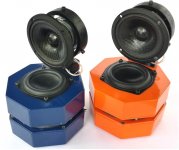
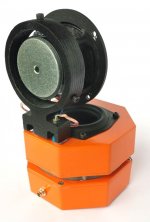
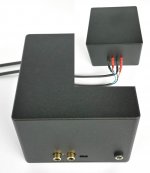
Measurements
After measuring the drivers and some playing with the DSP settings (700Hz 12dB/oct. LR crossover) the result was this frequency response:
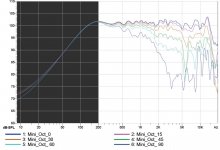
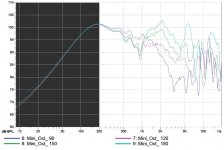
Measurement distance 400mm, 960mm above ground, 10ms time window, MLS w. 256kS in the middle of a large room with Groundsound XO Wizard Advanced.
Due to the fact that the speakers are usually placed on a shelf or board close to a wall the lower frequencies get some gain and this creates a fuller tonal balance.
I also tried an 80mm PMMA pipe with 90mm length stuffed with BAF wadding behind the Seas wideband like the LXmini, but at least to my ears it did not make that much of a difference with these speakers. The measured response curves with and without the pipe are not very different:
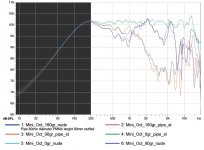
I also made a quick measurement with a large chipboard approx. 250mm behind the speaker:
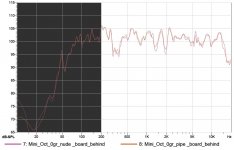
Measurement distance 400mm, 960mm above ground, 200ms time window, with room influence and reflections and 600*600mm board 250mm behind speaker, MLS with 256kS, smoothed
If desired, it is easy to attach a plastic pipe to the plywood ring holding the wideband, but for ease of portability I have not done it so far.
Conclusion
After listening for a few weeks I am really happy with the very natural, open and dynamic sound (within physical limits) as well as the compact size of these speakers. If more bass output is desired a subwoofer would be an option, but it increases the weight and volume of the speakers as well as consuming more power.
Combined with a high-quality aptX Bluetooth receiver (e.g. Philips AEA2700/12) and a notebook these speakers are convenient to listen wireless with a natural sound while on the move.
I am an engineer who is fascinated by audio DIY for already more than 27 years. After having learned a great deal about audio, speakers and electronics in this forum I would like to share my latest little speaker project, the MiniOctagon.
Scope
Inspired by the work of SL and his great website with a wealth of information regarding active speakers and especially dipoles with his latest work, the LXmini I had the idea of an even smaller, easily portable speaker for a chalet or hotel room while preserving the astonishing sound quality of an unbaffled dipole speaker from the midrange upwards. The compromise is a limited output volume (around 95 dB, small rooms) and a restricted bass response. A sealed enclosure with a high pass capacitor and a -3dB frequency of about 80Hz (third order roll-off) seems achievable for such a small speaker and the usual close-by walls create an additional LF boost. Going fully active with a DSP and Class D amplifiers maximizes energy efficiency (and hence battery life) as well as flexibility.
Driver Selection
Sifting through the available LF drivers and the volume they need for a given cutoff frequency and output volume led me to the Dayton ND91-4, which offers low enclosure volume requirements and a comparably high volume displacement due to its long stroke of 4.6mm at a competitive price point.
For the MF/HF part I took the Seas MU10RB-SL wideband driver which is a fantastic midrange in the LX521 and which is also used by SL in the LXmini. Swapping it for the also excellent Scan Speak 10F/4424g00 increased the midrange efficiency, but the sonic differences were small, whereas the price is double. So the MU10RB-SL is the one for this project.
Crossover and Amplifier
Due to the active nature of this project a DSP and 4 channels of amplification are needed. I am not into passive speakers any more. A DSP is such a flexible tool and can be reused for any other project. The MINI DSP 2*4 is a competitively priced and proven product with a wide supply voltage range. The Hifimediy T1-M TK2050 9 - 24V amplifier is cheap and also has a very wide supply voltage range. One can use any 12V solar battery, a car cigar jack or a notebook PSU up to 24V, which I use at the moment to power the amps as well as the DSP.
Enclosure
Looking for an enclosure with about 0.9 liters volume and the smallest possible outer size I came across the diecast aluminium enclosures from Hammond, which can be ordered already painted. Painting is very time consuming…
I discovered the Octagon enclosures by Hammond, which can be bought in various colors. Two of them provide enough volume for the ND91-4 in a sealed enclosure with a high pass capacitor. Screwed together with a 10mm thick sheet of PMMA in between they are also visually appealing (at least to my eye). The DSP and the 2 amp boards were put in a rugged black square Hammond enclosure (120*120*100mm).
The aluminium speaker enclosure was damped with 2mm thick STP silver, a self adhesive car sound dampener. The air volume was damped with BAF wadding (Bondum 800) in the lower octagon and around the walls of the upper octagon.
The wideband is held in place by a ring made from 22mm birch plywood, which is strong enough for thread cutting. The ring is fixed on the enclosure with banana plugs, which also carry the signal to the wideband driver. For ease of transport the wideband with its ring can also be removed quickly from the enclosure thanks to the bananas. The total size of the speakers is 130*130*220mm, weight is 1.4kg each. The connection from the amp to the speaker is done with a 4-wire Belden sensor cable and a M8 sensor connector with 4 pins (all within one M8 thread, great stuff).



Measurements
After measuring the drivers and some playing with the DSP settings (700Hz 12dB/oct. LR crossover) the result was this frequency response:


Measurement distance 400mm, 960mm above ground, 10ms time window, MLS w. 256kS in the middle of a large room with Groundsound XO Wizard Advanced.
Due to the fact that the speakers are usually placed on a shelf or board close to a wall the lower frequencies get some gain and this creates a fuller tonal balance.
I also tried an 80mm PMMA pipe with 90mm length stuffed with BAF wadding behind the Seas wideband like the LXmini, but at least to my ears it did not make that much of a difference with these speakers. The measured response curves with and without the pipe are not very different:

I also made a quick measurement with a large chipboard approx. 250mm behind the speaker:

Measurement distance 400mm, 960mm above ground, 200ms time window, with room influence and reflections and 600*600mm board 250mm behind speaker, MLS with 256kS, smoothed
If desired, it is easy to attach a plastic pipe to the plywood ring holding the wideband, but for ease of portability I have not done it so far.
Conclusion
After listening for a few weeks I am really happy with the very natural, open and dynamic sound (within physical limits) as well as the compact size of these speakers. If more bass output is desired a subwoofer would be an option, but it increases the weight and volume of the speakers as well as consuming more power.
Combined with a high-quality aptX Bluetooth receiver (e.g. Philips AEA2700/12) and a notebook these speakers are convenient to listen wireless with a natural sound while on the move.
A sealed enclosure with a high pass capacitor and a -3dB frequency of about 80Hz (third order roll-off) seems achievable for such a small speaker and the usual close-by walls create an additional LF boost. .........................................................................Two of them provide enough volume for the ND91-4 in a sealed enclosure with a high pass capacitor.........................................
...and the HP cap value is ....??
The high pass cap value for the ND91-4 is 408uF. Due to size restrictions in the enclosure I used a bipolar electrolytic cap with 390uF/63V parallel to a 18uF MKP.
The speaker together with the cap represents a third order highpass filter. The cap creates some LF boost due to interacting with the complex speaker impedance. It lowers the impedance right below fc as well as offering protection against too high cone excursion at very low frequencies by increasing the impedance in that region.
well done hope they sound great.
Thank you, in my opinion they do sound great for their size.
- Status
- Not open for further replies.
- Home
- Loudspeakers
- Multi-Way
- MiniOctagon: Small Portable Dipole Midrange Speakers